Switch Statement Example Java
Switch Statement Example Java: The default statement is optional and can appear anywhere in the switch block. Note that if the default statement is used as the last statement in the switch block, no interruption is required. As mentioned above, the break statement must be used anyway, otherwise the statements in the switch block will be ignored. There is no need for a break statement after default, because the control itself will exit the switch after the default case, but if you still use break after default, it will not cause a syntax error.
Explain Switch Statement with Example in Java
If you omit the break statement, the computer will only move forward after the case is complete and execute the instructions associated with the next case mark. Note that you can completely omit one of the sets of statements (including break).
The following code example SwitchDemo2 shows how a statement can have java switch multiple case labels. The switch statement also works with the Java String class, enumerated types, and some special classes. In fact, it is somewhat similar to the java if statement, although the Java switch statement offers a more concise syntax and slightly different behavior than other java conditional statements.
Optimizing Java: Practical Techniques for Improving JVM Application Performance 1st Edition
Java switch expressions are useful when you need to get a value based on another value. In the case of a switch statement, the expression is tested against a single integer, enumerated value, or string object. These decision statements are very useful when you want to split code based on conditions or expressions and want to test multiple options. Another difference is that if statements can test expressions based on conditions or ranges of values.
The operator or variable used as a switch statement in java must be a constant value, otherwise it will be invalid. In Java, the value of the variable is allowed to be used only when the value has been permanently assigned to the variable.
Learn Java in One Day and Learn It Well (Learn Coding Fast)
In this case, the constants in the case labels must be enumerated values. Of course, the computer already knows that the value in the case label must be of an enumerated type, as it can judge from the type of expression used, so you don't need to specify the type name in the constant.
Switch Case Program in Java Using Scanner
Each value is called a case, and the triggered variable is checked for each case. The switch checks the value of a variable and compares that variable with each different value from top to bottom. The default statement is executed if none of the Switch options match the value of the Switch variable.
Since the switch statement defines its own block, there is no conflict between the case constants in the inner switch and the constants in the outer switch. A Switch statement in Java is a branch or decision statement that provides a way to execute code in different cases or parts that depend on the value of an expression or condition.
Buy Head First Java, 2nd Edition 2nd Edition
In this section, we will first look at an example if-else statement, and then also use the java switch statement example java to solve the same example, you can easily see the similarities between them. Below we provide some code examples to demonstrate the use of switch statements, the role of break statements, switch/case parameter requirements, and string comparison in switch statements.
A Switch Case Statement in Java is a Control Statement
We can decide whether to use radio buttons based on the readability and the type of the values being compared. We can use a switch as part of an external switch command sequence.
In the following example, we have used a nested switch in combination with the break keyword. An instruction in a switch block can be labeled with one or more predefined cases or labels. The switch string in java, the switch expression is compared to the expressions associated with each case label, as if using the String.equals method.
Java Switch Multiple Case
After evaluating the expression, the statement will be executed appropriately. The data type of the expression in the switch can be byte, char, short or int. After a match is found, the statement associated with the constant will be executed.
OCA / OCP Java SE 8 Programmer Certification Kit
We've provided every possible example, whether it's toggle with an integer or toggle with a string. So, we used an inner and outer switch to set different cases for the values of a and b.
This switch example first creates a variable called amount and assigns it the value 9. In the switch expression, we pass this variable to color, which means that any case statement that has a value that matches the color variable will execute that case statement. Since this is not the same thing either, it prints the statement in the default case.
Switch Case in Java Example Programs with User Input
Assuming that the value is different from the first case value, it will check the subsequent case value and execute the corresponding statement. Since we have used break statements in both the outer and inner switches, it ignores the remaining case values and exits the switch case java string. Since we did not use break statement in any case statement, java case switch will execute all case statements.
In the previous program, we passed an integer value of 2 to the switch, and then passed control to case 2, but after case 2, we did not have a break statement to force the thread to run until the next case to the end. ...In the above code, we pass an integer value of 4 to the switch that should execute case 4. However, after case 4, we do not have a break statement to force the process to follow the case until the end...
When the triggered variable is equal to a register, the statements following the register will be executed until a break statement is reached. If break is not used, all cases after the corresponding case will also be executed. The expression is evaluated once and compared with the value of each case.
If none of the case values match the argument, the block is executed with a default label. This is why we have to use default in case of a switch, so that if there is no hook that matches the condition, the default block is executed. This statement is used in switch expressions to tell the Java compiler that this case statement is selecting the return value for the switch expression rather than selecting a block of code to execute.
Java interrupt statements can be used (optionally) to terminate a sequence of executable files in a case. Control flow continues from the first statement following the switch block.
The code uses a switch statement example java to display the name of the day based on the value of the day. The code uses a switch statement to display the month name based on the month value. Using a for loop, we loop through all the values of the enumeration and use switch case to print the corresponding full month name.
Related Posts:

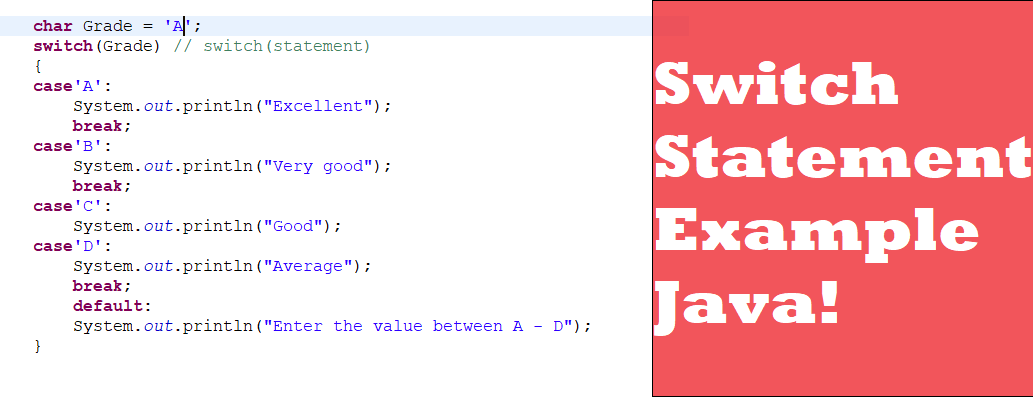
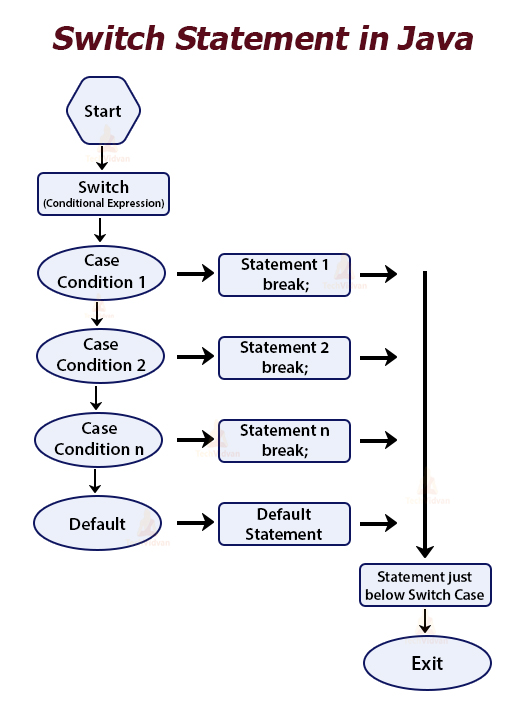



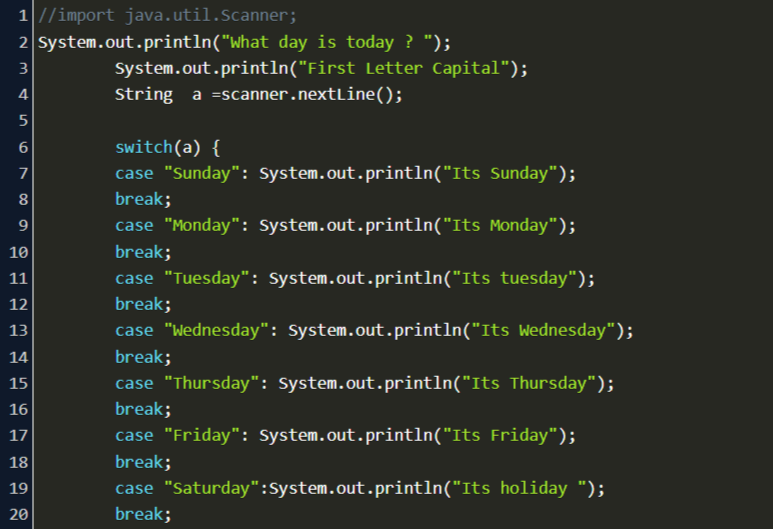
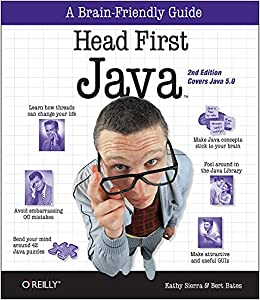



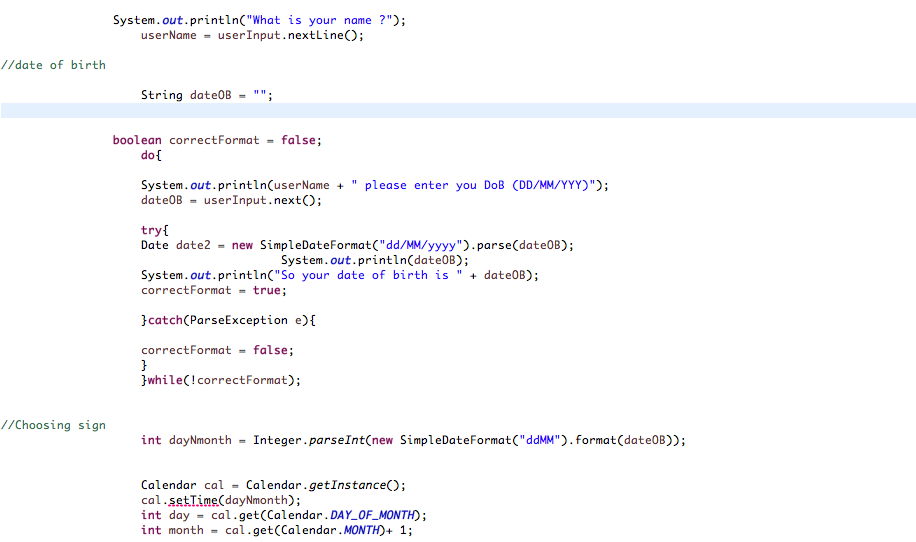
Comments
Post a Comment